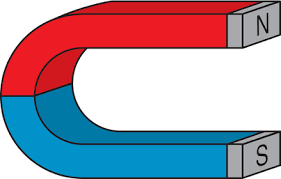Magnetism is the study of magnets and it’s properties. A magnet is a piece of iron that attracts objects made of iron families towards it. A magnet can be either natural or a piece of iron core that becomes a magnet because of an electric current passing through it.
Magnets can be made with different shapes and with poles at desirable points.
Bar magnets is the most common type of magnets especially for investigation of magnetic properties
Properties of magnets
- They attract other materials called magnetic materials
- When allowed to float freely, they settle with their poles facing Earth’s geographic north and south.
- Magnetic strength is strongest at the ends of the magnet called poles.
- Magnetic poles have the same magnetic field strength.
- Magnetic poles are called south pole and north pole and always in pairs that cannot be separated.
The basic law of magnetism
It states that:
Like poles repel, unlike poles attract.
When two magnets are suspended freely, the poles that faces the same direction will repels each other.
Only two similar magnetic poles can repel each other.
Magnetic poles can attract poles opposite to them and also magnetic materials that are not magnets.
Not every material that is attracted by a magnet but only some materials especial those from iron family. Materials that can be attracted by a magnet are usually referred to as magnetic materials while those that cannot be attracted by magnets are referred to as non-magnetic materials.
Magnetic attraction
If the head of light pin is brought to contact with north pole of a magnet and then the north pole of the a second magnet brought close to the tip of the hanging pin, the hanging tip of the pin is repelled by the north pole. see the illustrations below.

This shows that the pin has acquired a north pole at it’s hanging end otherwise there would be no repulsion.
If the pin was attached to the south pole of the magnet, the free end of the magnet is observed to repel a south pole and attract a north pole showing that it is a north pole.
The causes of attraction is due to magnetization of the pin by the process called induction. The material attracted gains an opposite pole the to that of attracting pole of the magnet by induction, at the end of the object in contact with the magnet.
Induction is the process by which a material becomes a magnetic due to its nearness to the magnetic or by being inside a b field.
A magnetism results from induction is known as the induced magnetism. The resulting magnetism may be retained for some time after the magnetism is removed.
Soft and hard magnetic materials materials
When magnetic materials are removed from magnetic field, they loose their magnetism. How fast the magnetism is lost depends on the material used.
When iron and steel are brought to contact with pole of a magnet ,iron is observed to have stronger magnetism than steel. see the illustrations below.

When they are removed from the magnetizing field, steel is observed to have stronger magnetism than iron as in illustrations below.

This shows although iron is more strongly magnetized in the presence of magnetic field and it’s magnetism is rapidly lost as the magnet is removed. Nickel and cobalt would also behave like iron. Steel remains it’s magnetism more than the iron.
Materials that are easily magnetized and therefore readily attracted by a magnets are called soft magnetic materials. Soft magnetic materials loses it’s magnetism quickly when magnetizing agent is removed.
Steel does not gain magnetism quickly but slowly, however, it retains it’s magnetism for much longer time and sometimes permanently magnetized.
Materials that are not easily magnetized or attracted by a magnets but retains their magnetism for long time after magnetization are called Hard magnetic materials.
Related topics
- Understanding magnetic fields
- Mutual induction in transformers
- Electromagnetic Transformers
- The Lenz’s law
- Factors affecting magnitude of the induced e.m.f
- Hans Oersted
- Calculus Integration
- Induced Electromotive force
- Magnetic effect to an electric current
- Applications of electromagnetic waves


Leave a Reply